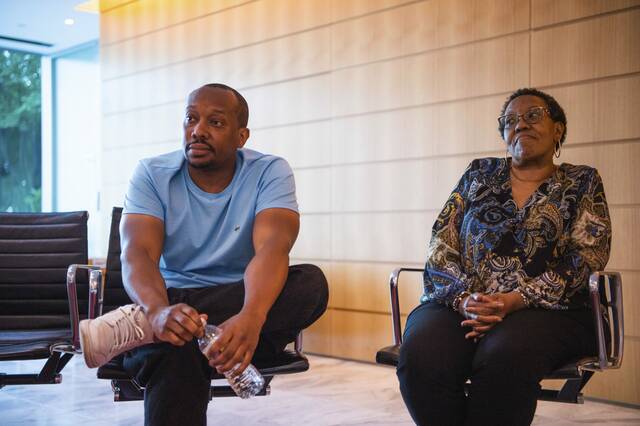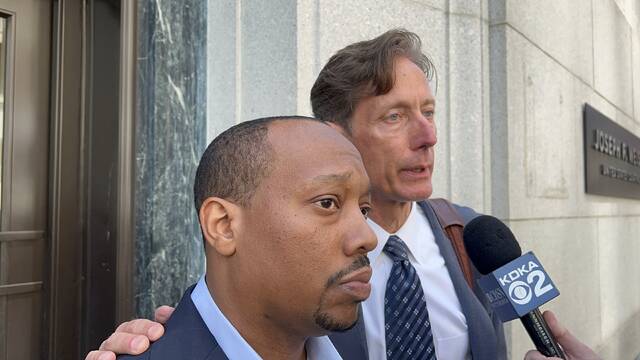2 sides in legal battle over fatal Bricelyn Street fire still making their case
When Greg Brown entered a plea 27 years after a fire on Pittsburgh’s Bricelyn Street killed three city firefighters, the government saw it as a victory.
Though the unusual Alford plea made earlier this year allows Brown to continue to proclaim his innocence and carries no additional sentence, he took the conviction.
Brown is as staunch as ever in denying involvement in the fire that investigators said was arson, but saw the outcome as a bitter end to his long-time fight.
Brown and his family sat down with the Tribune-Review to discuss what their lives have been like since the Feb. 14, 1995, fire at their home.
They talked about what happened the night of the fire — they believe it was accidental. They gave their account of the investigation and ultimately the conviction of Brown and his mother, Darlene Buckner, at trial.
They also talked about Brown’s fight to win his appeal and why he chose to enter a plea.
“Do you want to go to trial again with the same system that’s rigged and broken?” asked Brown’s brother, Fred Buckner. “Why would you run that risk again?”
In a highly unusual move, agents with the federal Bureau of Alcohol, Tobacco, Firearms and Explosives are also talking.
The agents who led the investigation then and leading up to the retrial also spoke extensively with the Tribune-Review to outline the evidence in the case, the science used in determining the fire’s cause and origin and why they continue to believe Brown is guilty.
“This was a righteous case,” said ATF Special Agent Matthew Regentin. “This was an incendiary fire that some of the best science we had then — and have today — corroborated.
“The truth always fits.”
‘It was up in flames’
Darlene Buckner was making a batch of macaroni and tuna salad for a family funeral luncheon late on Feb. 13, 1995, when she realized she didn’t have enough eggs.
She said she grabbed Brown, her teenage son, to go with her in the frigid conditions to pick up what she needed.
When they got near Bricelyn Street around 1 a.m. Feb. 14, they said they saw fire trucks. As they pulled into the alley behind the house, Brown got out of the car to see what was going on.
Buckner parked and headed toward her back porch — where she found a firefighter.
“‘Oh my God, this is where we live,’” she told him. “It was up in flames.”
Buckner, who was two months pregnant, ran around to the front of the house, searching for her husband, 2-year-old son, 19-year-old stepdaughter and 1-year-old granddaughter, who all had been home when she left for the store.
“I needed to see my family,” she said.
She finally found them across the street, watching with no coats and just slippers on their feet as the house where they’d lived since 1990 burned. They had gotten out when her step-daughter smelled smoke and alerted the others.
It was a huge relief.
Then the basement stairs collapsed, trapping three Pittsburgh firefighters inside the wood-frame house with aluminum siding.
Marc Kolenda, 27, Patricia Conroy, 43, and Capt. Thomas Brooks, 42, died.
A mountain of circumstantial evidence
Within hours, ATF Special Agent William Petraitis was on the scene.
He explained during an interview that typical protocol in a fire investigation calls for doing an external evaluation first and then reviewing the interior of the building — working from the least damaged areas to the most damaged.
In the Bricelyn Street blaze, Petraitis said, the fire appeared to start in the basement.
Of particular note, he said, was a large hole in the ceiling of the basement. The fire had consumed as many as 10 joists.
“It takes an exorbitant amount of energy to do that,” Petraitis said. “You start doing calculations. You can’t generate a flame that high in intensity without a product similar to gasoline.”
Lab tests later showed gasoline was found in the basement.
Working with the city of Pittsburgh’s arson squad, investigators determined the fire had been purposefully set.
“I absolutely believed it was an attack on the home,” Petraitis said. “I did not think anyone in the family was responsible for that fire for months.”
But as the investigators continued to do their work, he said, piece after piece of circumstantial evidence started to pile up.
- A neighbor told investigators Buckner left the night of the fire to go to the grocery store alone.
- First responders who saw Buckner return to the house that night said there was a car seat in the front passenger seat, meaning Brown would have had to sit in the back seat, which Petraitis said would be unusual.
- In a recorded jail call between Brown and one of his brothers, Regentin said, Brown said he was the “(expletive) sacrifice for this family.’”
- The neighbor who claimed to have seen Brown outside that night saw him before fire trucks were on scene.
- When Brown learned from a city investigator that night that three firefighters were killed in the fire, he collapsed and said, “Oh, God, no.”
- The family said they kept a gas can in the trunk of the car normally, but public safety officials found the gas can on the porch. Further, the family said the can was new and never had gas in it before, but when it was tested, it had traces of gasoline inside.
- The family purchased a $20,000 renter’s insurance policy that winter — the first they’d ever gotten for that home. Around that same time, they had been talking about buying their own home and needing about $5,000 for a down payment. They didn’t have enough money.
But perhaps most significant to Petraitis was how the kitchen door that led to the basement was found.
The family was insistent that Darlene Buckner had latched that door before she left for the store because she was worried about her toddler going down into the basement alone.
But Ronald Buckner told investigators that he saw thick black smoke emanating up the stairwell. If the door was latched, Petraitis said, Buckner would not have been able to see the smoke he described.
“The door is a very big problem. They are adamant they latched the door,” Petraitis said. “We find that important investigationally — when the scene is different than what it was when they saw it last.”
Petraitis, who was in the first class of the ATF’s certified fire investigator program, said the family eventually became suspects.
He likened it to balancing scales: “You add small grains and eventually, it tips one way or the other.”
‘Joke was on me’
In the immediate aftermath of the fire, the Red Cross provided assistance to the family, and they stayed at a Holiday Inn off the parkway for two nights.
“We had no idea what we were going to do,” Buckner said. “We were in shock.”
After that, they stayed with her sister on the North Side.
In March 1995, they got a month-to-month lease at Penn Plaza and pieced together their household with donated furniture and dishes.
At the same time, Brown, who was a junior at Westinghouse High School, stayed in the East Hills neighborhood with his dad and stepmother who lived two streets away. The house on Bricelyn Street remained under guard by police, ATF agents and dogs.
“I would have to walk past it every day,” he said.
The day of the firefighters’ funerals, the family said, the police questioned them about the fire.
“They interviewed us like we were suspects,” Brown said.
That was when the family realized they needed to hire an attorney.
But the case stalled. Eight months later, the ATF and Allegheny County District Attorney’s Office announced a $15,000 reward for information about the fire.
A neighbor had gone to a nearby fire station before the reward was announced and said he had information about the Bricelyn Street fire, but no one ever followed up on it, Petraitis said.
The day the reward was announced, the same neighbor came forward again and said he saw Brown on the night of the fire watching from the street as smoke billowed from the house. It was before the fire trucks were on scene.
That time, the information was relayed to the right people.
Then, a teen with whom Brown had been housed at a youth detention camp claimed that Brown had bragged to him about setting the fire that killed three firefighters in Pittsburgh. He claimed he set it for insurance money, and that he was going to get a car out of it, Petraitis said.
Buckner and Brown were arrested on April 12, 1996.
Buckner was at home, watching Sesame Street with her infant and 3-year-old when the police arrived. Simultaneously, Brown was arrested at his uncle’s home in Billings, Mont., where he had spent the previous six months.
They were charged with second-degree murder — killing someone in the commission of another felony. In this case, the felony was arson.
Investigators said Brown set the fire at his mother’s request to collect on a $20,000 renter’s insurance policy that she had taken out three months earlier.
Buckner questioned that as a motive, noting that belongings they lost in the fire added up to much more than $20,000.
“They built a case out of nothing,” she said.
Although Buckner got bond after about a month at Allegheny County Jail, Brown did not. He flew back to Pittsburgh with investigators, who questioned him constantly.
“They were trying to get a confession,” Brown said. “They tried the whole time.”
“‘Help your mother, then, if you don’t want to help yourself,’” they told him.
Brown told them he didn’t have anything to say. He and his family thought, eventually, detectives would figure out they didn’t do it.
“I knew it was severe. I knew I was in trouble,” he said. “It was going to be an acquittal or life sentence — I knew that much.”
But Buckner said, “We had faith in the system.”
“I thought the evidence would show we didn’t do it, and it would be over,” said her husband, Ron Buckner.
“Joke was on me,” Brown said.
Listening to the verdict as it was announced by the crying foreperson — Buckner guilty of insurance fraud, Brown guilty of three counts of second-degree murder — “was like a nightmare,” Buckner said.
“I couldn’t believe they could do this to us.”
Even though Buckner was sentenced only to probation, her son, then 19, was sentenced to a mandatory term of life in prison without parole.
“‘There’s no winners here,’” she thought to herself then. “I’ll never be free unless my child is free.’”
For Buckner, the conviction meant she could no longer work as a licensed practical nurse. For the 25 years since then, she said, she has worked at a variety of odd jobs.
“It’s been 30 years of horrific living for something we had nothing to do with,” she said.
‘I knew I had a real shot’
Brown’s brothers Darronté and Fred Buckner remember the monthly, six-hour bus trips they took with their parents to see him at the State Correctional Institution at Graterford in Montgomery County.
The bus trips were taken through Families on the Outside, which helped arrange trips for those whose loved ones were incarcerated there. The family had to leave very early in the morning.
The trips were expensive and grueling with two young children, but they were important, their mom said.
“We just did what we needed to do,” she said. “That’s why they have the relationship with him that they do.”
Eventually, she got a job with the program coordinating the trips and collecting payment.
“To me, it was cathartic,” she said.
Fred Buckner has a clear memory, from when he was 7, of the moment he understood that Brown couldn’t go home with them. Then, when Darronté Buckner was around the same age, he walked up to a correctional officer and asked, “‘Can my brother come home with us?’”
Brown, who consistently maintained his innocence, remembers that the guard became emotional.
He said the family support continued to drive him to fight the conviction, but the bitter reality set in during every visit: “I couldn’t leave with them.”
For several years in prison, Brown worked cleaning the block or in the kitchen, read books and played football and basketball.
In 2004, Brown started to actively learn the law and work on his appeals himself. He knew he needed a private investigator to find new evidence.
Around that time, he contacted the now-defunct Innocence Institute at Point Park University. For several years he worked with student journalists and filed Freedom of Information Act requests. Then they found the evidence Brown knew he needed.
At trial, the two main witnesses against Brown — his neighbor on Bricelyn Street and his bunkmate from the youth detention camp — had testified they were not promised payment in exchange for the information they provided.
But the Innocence Institute got copies of the canceled checks the witnesses received.
In the summer of 2010, Brown received the evidence in his prison mail.
“When I got that, I knew I had a real shot,” he said. “That was it.”
He filed a petition based on the newly discovered evidence in 2010, and Allegheny County Common Pleas Judge Joseph K. Williams III held a hearing on the matter in 2012.
At that hearing, evidence was presented that both witnesses, at the time of trial, anticipated being paid reward money by the ATF for their testimony.
More than 1½ years later, Williams granted Brown a new trial, finding that the prosecution’s failure to disclose the payment to the two witnesses was improper and that the trial likely would have ended with a different verdict had the jury heard that information.
The commonwealth appealed the same day, but on March 20, 2015, the state Superior Court affirmed the decision, and the state Supreme Court refused to take the case.
Brown was left in limbo waiting for the state to retry him. The district attorney’s office attempted to have Williams recuse himself from the case over alleged bias. When he refused, jurisdiction was handed over to federal prosecutors, who indicted Brown on a single count of malicious destruction of property by fire resulting in death — which could carry a life sentence.
When it became clear that Brown would be retried, ATF Special Agent Regentin, who had joined the bureau in 2001, was asked to review the original investigation and findings and write a report.
He spent many months poring over the original files, reports, video evidence, diagrams and test results. He reviewed thousands of pages, conducted test burns at the ATF’s burn lab in Maryland in 2015 and talked to other experts in the field.
His conclusion? It had to be arson based on the pattern and extent of damage in the house, Regentin said.
Like Petraitis, he points to the damage in the basement — particularly the fact the fire burned so hot and so high that it consumed the ceiling joists.
There was speculation among the defense attorneys that the fire could have started in a pile of laundry — or in a wardrobe in the basement.
To test that theory, Regentin said, he conducted a number of tests at the burn lab. They burned small piles of laundry, big piles and piles with gasoline poured on them. They burned cotton fabrics, synthetics and a combination to gauge the speed and intensity of the fire.
“If it was just a fire that had started in some laundry with no accelerant, it would have burned for a period of time, but it would have depleted the oxygen,” Regentin said. “There wouldn’t be enough flame, height, energy in the normal combustible materials in that room to reach the ceiling.”
And even if there had been, he continued, without an accelerant such as gasoline, the fire would have likely burned out without involving the ceiling.
“You need a certain heat flux on that ceiling to even get the wood to ignite,” Regentin said. “The only thing to get that fire from the laundry to the ceiling to cause the damage that it did was to involve an introduced accelerant like gasoline.”
Regentin has zero doubts that the fire was intentionally set and zero doubts that Brown is the one who set it.
Petriatis said the same.
“This was an important fire. Every available resource was sought,” Regentin said, noting that the investigating team included the city, county and ATF.
Regentin said that no one wanted it to be arson.
“I’ve written lots of undetermined fires before,” he said.
He confirmed Petraitis’ cause and origin determination.
“My conclusion was yes, he followed the scientific method and reached a conclusion that was proper and did not rely on bad science,” Regentin said.
Addressing accusations
It was highly unusual for the ATF to allow its agents to talk about the Bricelyn Street fire investigation.
But Special Agent Robert Cucinotta, who serves as the agency’s public information officer in Pennsylvania, said after so many years of silence, it felt necessary
“In this instance, false accusations have been directed toward ATF, and questions about the handling of the investigation by specific agents have arisen — in both court filings by the defense and in the media itself,” he said. “Our intent is to always let the facts come out in the court proceedings. In this case, Mr. Brown was convicted and sentenced in June 2022.”
Because the investigation is no longer active, Cucinotta said the ATF found value in addressing outstanding accusations and presenting “the sound scientific basis indicating this fire was an arson committed by Mr. Brown.”
“For over a decade, facts and credible evidence have been ignored by the defense in their filed motions and statements to the media,” he said.
Petraitis and Regentin expressed frustration at Brown’s defense attorneys throughout his appeal.
Petraitis, who retired in 2000 and investigated many fatal fires, said Bricelyn Street sticks out for a couple of reasons — three firefighters were killed, and “because it keeps coming up.”
‘It’s not a win’
For nearly six years after the accusations against Brown were moved to federal court, the case remained pending.
Brown’s attorneys, Elizabeth DeLosa from the Pennsylvania Innocence Project, Dave Fawcett and federal First Assistant Public Defender Michael Novara, attempted to get the case dismissed — lobbying the U.S. Attorney’s office, filing motions alleging double jeopardy and filing federal appeals when they struck out at the district court level.
They also plotted out their trial strategy, including obtaining reports from nationally recognized fire experts who speculated that the ATF’s initial designation of arson was wrong.
But in the end, they didn’t need them.
The case finally ended on June 8 when Brown reached a rare agreement with the U.S. Attorney’s office to enter an Alford plea. It came with no additional penalty — other than the 20 years he already served in prison.
Under the law, a defendant maintains his innocence with an Alford plea but concedes that entering the plea and taking the conviction is the best path for him.
Brown said it was a difficult decision.
“It’s not a win for me or my family,” he said. “It’s bigger than me. We got an extended family. They went through all of this with me.
“It’s not a win.”
The idea of the Alford plea first came up in the summer of 2021, Fawcett said.
“We took a lot of time thinking about it,” he said.
Alford pleas, DeLosa said, are exceedingly rare. To obtain one, the local U.S. Attorney’s office is required to get permission from the Department of Justice and attorney general.
DeLosa was told that only 11 people have been able to negotiate them in the past 50 years.
Brown and his attorneys believed they had a good chance at trial. But, they said, he’d already been wrongfully convicted once before.
“Many people weighed in and said that if there’s any chance at all, even a 1% chance, that Greg might suffer another wrongful conviction, why would you do it?” Fawcett said.
Brown’s friend told him it’s like a boxing match: “‘You wanted a knockout, but you won by decision.’”
“That’s exactly how I feel,” Brown said. “I would never have pleaded guilty.”
Paula Reed Ward is a TribLive reporter covering federal and Allegheny County courts. She joined the Trib in 2020 after spending nearly 17 years at the Pittsburgh Post-Gazette, where she was part of a Pulitzer Prize-winning team. She is the author of “Death by Cyanide.” She can be reached at pward@triblive.com.
Remove the ads from your TribLIVE reading experience but still support the journalists who create the content with TribLIVE Ad-Free.





